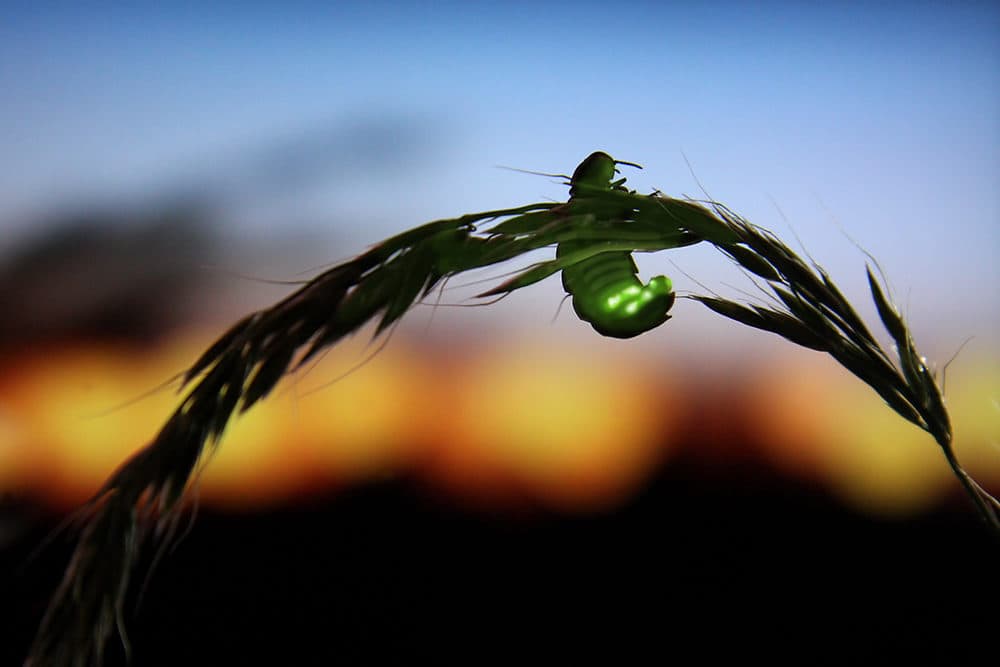Advertisement
Top Threats To Fireflies Include Habitat Loss, Pesticides And Light Pollution

Fireflies don't flash their lights just so kids can chase them around at dusk.
Those lights are used to attract mates. And when the night sky is lit up by streetlights and neon signs, it spoils the mood.
"Trying to find mates against a background that's very, very bright — it's a lot harder to see those signals," said Tufts University insect ecologist Sara Lewis. "If you artificially increase the brightness at night, firefly males might continue to flash, but the females don't respond."

Lewis is lead author on a new study published Monday in the journal BioScience that looks at global threats to fireflies, also known as lightning bugs. She and her team surveyed firefly experts around the world and asked them to rank threats to the insects. The top three, in order: habitat loss, light pollution and pesticide use. Further down the list: water pollution, invasive species and climate change.
"This paper is a really valuable synthesis of what the concerns are, and what the issues are globally with regard to fireflies," said Christopher Cratsley, a biologist at Fitchburg State University and science adviser to Mass Audubon's Firefly Watch program. Cratsley added that the paper "does a great job synthesizing the research that has been done so far on each of these threats. And that research is in many ways still in its infancy."
There are about 2,000 species of fireflies worldwide, and some — like the synchronous fireflies that light up Mayalsian mangroves — have significant ecotourism and cultural value. Cratsley said at least 20 firefly species live in Massachusetts, but nobody knows the exact number of species or the total population.
But ask a middle-aged local resident, and they'll tell you there are a lot fewer lightning bugs than there used to be.
Cratsley said the data so far doesn't bear that observation out. Then again, there isn't much data about fireflies in Massachusetts — the Firefly Watch Citizen Science Project, which gathers information on the insects each summer, has only existed for a decade.
"I do think that people's anecdotal reports over a longer timespan are very real," Cratsley said. "I think there's a little bit more stability in this region for some of the major threats. Although, there are obviously new ones on the way, like climate change."
Study author Lewis said that while climate change scored lower on the list of global threats, it is intimately intertwined with habitat loss.
"Climate disruption – including sea level rise, drought, etc. – can increase habitat loss and degradation," she wrote in an email.
Habitat loss is a critical problem for firefly species that specialize in particular habitats, such as the Malaysian fireflies that specialize in mangroves, Lewis said. The species suffered drastic declines when large areas of mangroves were cleared for palm oil plantations, shrimp farms and flood mitigation.
Fireflies that are less dependent on a particular habitat are faring better, Lewis said. Southern New England's 'Big Dipper' fireflies — so named because the males dip down and rise up while flashing — "seem to be doing really well," she said. "They're the fireflies in Central Park, in Prospect Park in New York. They can survive in lots of different habitats."
Lewis said she was initially surprised that light pollution scored so high on the danger list. But there's a fair amount of scientific evidence showing that a brightly-lit night sky interferes with the insects' courtship signals, she said.
"Female fireflies actually have a preference for very, very small differences in the flash pattern of firefly males," Lewis said. "Females prefer males that either give flashes more quickly or flashes that are slightly longer in duration."
"The females are really inhibited from responding to males -- to continuing that courtship dialog — if there's a bright background," she adds.
Lewis said that many insects are understudied, including fireflies. She said she hopes her paper will help spawn further research on firefly species that seem especially threatened.
In the meantime, people can help reduce threats to lightning bugs, Lewis said. Try to protect open space where fireflies congregate, limit — or eliminate — pesticides on lawns and gardens and shut off household lights at night.
"Fireflies are a kind of a special part of Earth's biodiversity. It might not really matter if we lose like one firefly species here and maybe another firefly species there," Lewis said. "But it's kind of like extinguishing a whole roomful of candles one by one, right? You might not even notice when the first few flames flicker out, but in the end, you're left sitting in darkness."
